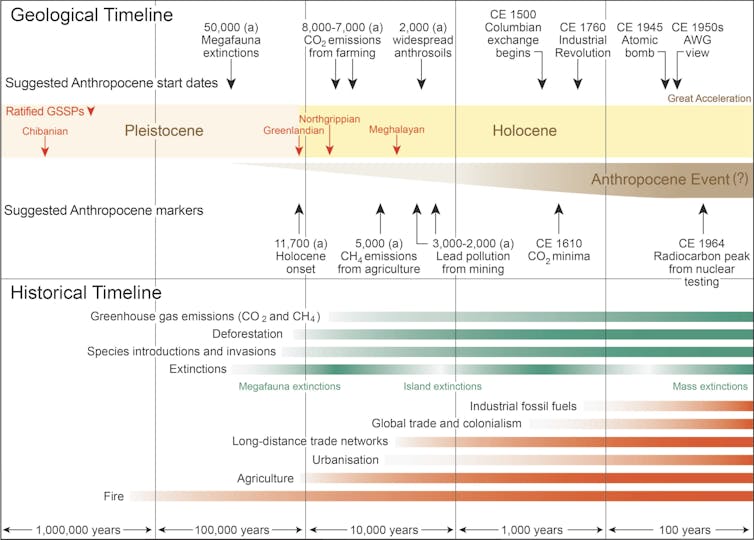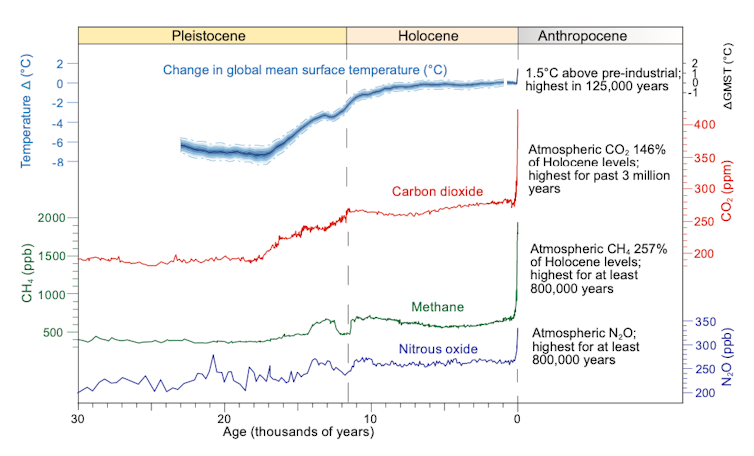 Simon Turner, Senior Research Fellow in Geography at University College London; Colin Waters, Honorary Professor of Geology at University of Leicester; Jan Zalasiewicz, Professor of Palaeobiology at University of Leicester; and Martin Head, Professor of Earth Sciences at Brock University, wrote a piece recently published in The Conversation about why the Anthropocene should be a new geologic epoch.
Simon Turner, Senior Research Fellow in Geography at University College London; Colin Waters, Honorary Professor of Geology at University of Leicester; Jan Zalasiewicz, Professor of Palaeobiology at University of Leicester; and Martin Head, Professor of Earth Sciences at Brock University, wrote a piece recently published in The Conversation about why the Anthropocene should be a new geologic epoch.This article written by Simon Turner, Senior Research Fellow in Geography at University College London; Colin Waters, Honorary Professor of Geology at University of Leicester; Jan Zalasiewicz, Professor of Palaeobiology at University of Leicester; and Martin Head, Professor of Earth Sciences at Brock University, originally appeared in The Conversation.
Geologists on an international subcommission recently voted down a proposal to formally recognise that we have entered the Anthropocene, a new geological epoch representing the time when massive, unrelenting human impacts began to overwhelm the Earth’s regulatory systems.
A new epoch needs a start date. The geologists were therefore asked to vote on a proposal to mark the beginning of the Anthropocene using a sharp increase in plutonium traces found in sediment at the bottom of an unusually undisturbed lake in Canada, which aligned with many other markers of human impacts.
The entire process was controversial and the two us who are on the subcommission (chair Jan Zalasiewicz and vice-chair Martin Head) even refused to cast a vote as we did not want to legitimise it. In any case, the proposal ran into opposition from longstanding members.
Why this opposition? Many geologists, used to working with millions of years, find it hard to accept an epoch just seven decades long – that’s just one human lifetime. Yet the evidence suggests that the Anthropocene is very real.
Environmental scientist Erle Ellis was one critic who welcomed the decision, stating in The Conversation: “If there is one main reason why geologists rejected this proposal, it is because its recent date and shallow depth are too narrow to encompass the deeper evidence of human-caused planetary change.”
It’s an oft-repeated argument. But it completely misses the point. When Paul Crutzen first proposed the term Anthropocene in a moment of insight at a scientific meeting in 2000, it was not from realisation that humans have been altering the functioning and geological record of the Earth, or to capture all their impacts under one umbrella term. He and his colleagues were perfectly aware that humans had been doing that for millennia. That’s nothing new.
Crutzen’s insight was wholly different. He said that the Earth system – that is, the really fundamental things like atmospheric composition, climate, all ecosystems – had recently sharply departed from the stability that they had shown for thousands of years during the Holocene epoch, a stability which allowed human civilisation to grow and flourish.
It makes no sense, Crutzen said, to use the Holocene for present time. He conceived the Anthropocene as the time when human impacts intensified, suddenly, dramatically, enough to push the Earth into a new state. The science journalist Andrew Revkin (who thought up the name “Anthrocene” even before Crutzen’s inspiration) aptly called it the “big zoom”.
Flesh on bones
We’re part of the Anthropocene Working Group (AWG) that has been gathering evidence to put geological flesh on the bones of Crutzen’s concept. The AWG had a mandate: to assess the Anthropocene as a potential geological time unit during which “human modification of natural systems has become predominant”. Thus, not just any impact but a decisive one.
There’s now no doubt about this decisive change – nor that it has left sufficient marks in recent geological layers to justify the description of the Anthropocene as a geological time unit (for such a unit must be able to be read in layers of rock millions of years from now, and not just sensed as a change in conditions). These layers abound in fallout from nuclear bomb tests, microplastics, pesticides, fly ash, the shells of invasive species and much else.
But how can one show the difference between Crutzen’s idea and the “age of humans” Ellis wrote about, which he, with others, has proposed to call an “Anthropocene event” extending over 50,000 years or more? We can use the very diagram they used:

It’s a nicely laid out, easy-to-understand picture that summarises the changes caused by human activity over the last million years. All these things certainly happened. But what is lost here is any sense of the quantified rate and magnitude of change, other than by a little shading. Looking at it, you’d wonder what the fuss was all about.
That’s because there’s no Y-axis (the vertical one). It only has the X-axis, that of time. The Y-axis is what scientists use to show the magnitude of measurements such as temperature and mass. It’s absolutely crucial to get an objective, number-based understanding of what really is happening.
Now let’s see how things look when a Y-axis is added. This just shows the last 30,000 years, that includes all the Holocene, but doesn’t use a logarithmic scale (that is, it doesn’t squash up the big numbers) so it more clearly shows how things relate to time.

The speed and magnitude of recent change jumps out at you. The sharp upturns are essentially Crutzen’s Anthropocene, representing the last 72 years of what has been called the “great acceleration” of population, consumption, industrialisation, technical innovation and globalisation (a more detailed way of expressing the “big zoom”).
Similar graphs can be drawn for species extinction and invasion rates, or the production and spread of fly ash, concrete, plastics, and a host of other things. They show that Crutzen’s Anthropocene is real, evidence based, and represents an epoch-scale change (at least). The significance for us all, of course, is that the near-vertical recent trends in these graphs are still, for the most part, rising, zooming us into a new kind of planet. The repercussions cannot fail to last for many thousands of years – and some will change the Earth for ever.
Epoch vs event
So the Anthropocene as an epoch is very different from the “event” of Erle Ellis and others, which encapsulates all human influence on the planet (and so is about a thousand times longer than the epoch, and differs in many other ways). They’re both valid concepts of course, and have some overlap, just like a mouse in some ways overlaps with a blue whale (they’re both mammals, and share a good deal of their genetic code). But they’re different.
It’s absurd, therefore, to give them the same name: to take Crutzen’s term and appropriate it for a wholly different purpose, and in doing so obscuring the real meaning of his insight and its significance. Under a different name (the Anthropolithic, perhaps?), it could perfectly well complement an Anthropocene epoch.
Humans have had a long and complex impact on the planet, true. For almost all that time, they left their marks on Earth – but did not utterly overwhelm it. Less than a century ago, processes that began during the Industrial Revolution swung into overdrive. That’s the Anthropocene as an epoch. It’s real, it’s already made geology, and it won’t go away. Best to acknowledge it, to help us cope with its consequences.
![]()



